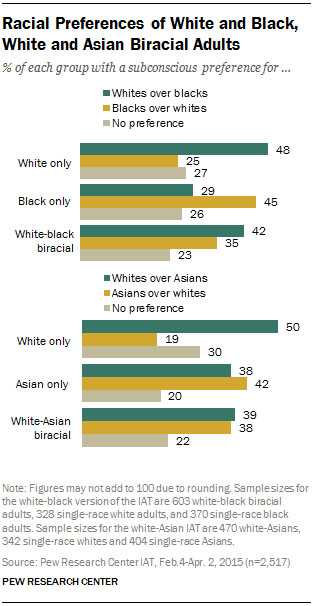Exploring Racial Bias Among Biracial and Single-Race Adults: The IAT
Rich Morin, Pew Social Trends, August 19, 2015
{snip}
{snip} Psychologists say that biased racial views are sometimes buried deep in a person’s subconscious–the byproducts of exposure to popular culture, the media and other factors.
To overcome these obstacles, Pew Research Center conducted an Implicit Association Test (IAT), a technique that psychologists say measures subconscious or “hidden” bias by tracking how quickly individuals associate good and bad words with specific racial groups.
{snip} Decades of IAT testing has generally showed that most humans display a bias against out-groups–people who are different from them. The question this study sought to answer is whether multiracial adults are less likely to have those biases, or simply more divided in their racial preferences. The answer, fairly definitively, turns out to be the latter.
Measuring Subconscious Racial Bias
Overall the test found that about three-quarters of respondents in each of the five racial groups, including those who are biracial, demonstrated some degree of implicit racial bias. Across the groups, only about 20% to 30% of those in the study were found to have little or no bias toward the races they were tested against. (Note: Because the pool of adults from which these samples were drawn is not representative of the adult population, the results of this study should be viewed as exploratory. See Appendix A: Methodology)
The study found wide variation in racial preferences within each of the five test groups. For example, while pluralities of whites and blacks were biased in favor of their own racial group, the same was not true among single-race Asians, who were more evenly divided in their subconscious preferences.
Single-race Asians were about as likely to show a bias for whites over Asians (38%) as they were to regard Asians more favorably than whites (42%). The remaining 20% did not clearly favor one race over the other.
By contrast, fully half of all single-race whites preferred whites over Asians, or more than double the share (20%) that preferred Asians. Three-in-ten whites favored neither race over the other.
The experiment also found that about half of all single-race whites in the Pew Research Center test automatically preferred whites over blacks (48%), including about a third (35%) who favored whites moderately to strongly. A quarter of all whites demonstrated an implicit bias for blacks, and a similar share (27%) was race-neutral.
Among single-race blacks, 45% were quicker to associate positive words with blacks and negative words with whites, including 28% with a moderate or strong automatic preference for blacks.
An additional 29% of single-race blacks favored whites, while 26% were race-neutral. (Single-race blacks and white and black biracial adults were not tested for bias against Asians. Asians and biracial white and Asian adults were not tested for bias against blacks.)
Two different but equally striking patterns emerged when the analysis turned to the level of bias among the two biracial groups. First, few biracial adults are race-neutral: Only 23% of white and black biracial adults and 22% of white and Asian biracial adults have little or no bias.
Second, in contrast to the lopsided pluralities of whites and blacks who favored their own race, biracial white and black adults were more evenly divided: 42% favored whites over blacks–including 23% who had a moderate or strong implicit preference for whites and 19% with a slight preference. At the same time, about a third (35%) preferred blacks.
A third pattern emerged from the results of those whose racial background includes both white and black ancestry: Their levels of bias look much more like those of white respondents than those of black respondents. According to the test, fully 42% of all white and black biracial adults had a pro-white bias, just short of the 48% of all whites that felt the same way and 7 percentage points higher than the share with a pro-black bias (35%).
Biracial white and Asian adults were even more divided in their subconscious racial preferences. Much like single-race Asians, about four-in-ten (39%) biracial white and Asian adults favored whites, while 38% preferred Asians.
{snip}
















